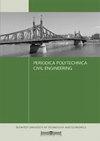The Modified Energy-based Method for Seismic Evaluation of Structural Systems with Different Hardening Ratios and Deterioration Hysteresis Models
IF 1.4
4区 工程技术
Q3 ENGINEERING, CIVIL
引用次数: 0
Abstract
Prediction of target displacement in structural systems plays a significant role in performance-based design and rehabilitation of structures. In this study, the γ factor for different hardening ratios, including 1, 2, 3, 5, 7.5, 10, and 15 percentages, stiffness-strength-deterioration models, and soil type classes is determined to modify the energy balance equation in performance-based plastic design (PBPD). Statistical results indicate that the effect of the hardening ratio, deterioration, and soil type class on the capacity curve is considerable. Therefore, a simple equation based on the period of the vibration and ductility is suggested to estimate the γ factor in different structural systems. Moreover, four 1-, 3-, 7-, and 12-story moment steel structures with various hardening ratios in the material are designed to validate the proposed method. The suggested values for the γ factor show exact results compared to collected displacements from time history analysis, while the error in the previous work was considerable. Statistical results showed that the mean error in the previous method in estimating target displacement for 1-, 3-. 7-, and 12-story structures is about 15%, 20%, 20%, and 32%, respectively. Conversely, the mean error in this study for estimating target displacement of 1-, 3-. 7-, and 12-story structures is about 10%, 7%, 6%, and 15%, respectively. Finally, the proposed method is examined on the empirical reinforced concrete (RC) bridge pier simulated numerically with fiber-based modeling. Similarly, the suggested equation estimates the target displacement appropriately for the concrete model compared to achieved displacements from nonlinear dynamic analysis.不同硬化比和劣化滞回模型结构体系抗震评价的改进能量法
结构体系目标位移的预测在基于性能的结构设计和修复中起着重要的作用。在本研究中,确定了不同硬化比(包括1、2、3、5、7.5、10和15百分比)、刚度-强度-劣化模型和土壤类型类别的γ因子,以修改基于性能的塑性设计(PBPD)中的能量平衡方程。统计结果表明,硬化率、劣化率和土壤类型对承载力曲线的影响是相当大的。因此,提出了一个基于振动周期和延性的简单方程来估计不同结构体系的γ因子。此外,设计了4个具有不同材料硬化比的1层、3层、7层和12层弯矩钢结构来验证所提出的方法。与从时间历史分析中收集的位移相比,建议的γ因子值显示了精确的结果,而先前工作中的误差相当大。统计结果表明,在1-、3-的情况下,前一种方法估计目标位移的平均误差较小。7层和12层结构分别约占15%、20%、20%和32%。反之,本研究估计目标位移的平均误差为1-,3-。7层和12层结构分别约占10%、7%、6%和15%。最后,利用纤维模型对钢筋混凝土桥墩进行数值模拟,验证了该方法的有效性。同样,与非线性动力分析获得的位移相比,建议的方程对混凝土模型的目标位移进行了适当的估计。
本文章由计算机程序翻译,如有差异,请以英文原文为准。
求助全文
约1分钟内获得全文
求助全文
来源期刊

Periodica Polytechnica-Civil Engineering
工程技术-工程:土木
CiteScore
3.40
自引率
16.70%
发文量
89
审稿时长
12 months
期刊介绍:
Periodica Polytechnica Civil Engineering is a peer reviewed scientific journal published by the Faculty of Civil Engineering of the Budapest University of Technology and Economics. It was founded in 1957. Publication frequency: quarterly.
Periodica Polytechnica Civil Engineering publishes both research and application oriented papers, in the area of civil engineering.
The main scope of the journal is to publish original research articles in the wide field of civil engineering, including geodesy and surveying, construction materials and engineering geology, photogrammetry and geoinformatics, geotechnics, structural engineering, architectural engineering, structural mechanics, highway and railway engineering, hydraulic and water resources engineering, sanitary and environmental engineering, engineering optimisation and history of civil engineering. The journal is abstracted by several international databases, see the main page.
 求助内容:
求助内容: 应助结果提醒方式:
应助结果提醒方式:


